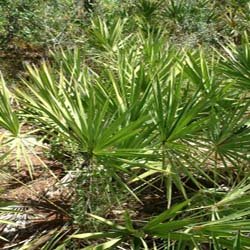Saw Palmetto
| Page Content |

|
Introduction
[Top]
Serenoa repens is known as saw palmetto and American dwarf palm tree and cabbage palm. It is the only the species which is classified in the Serenoa genus. It mostly grows in the south eastern part of the U.S. It is a very slow growing plant and can live for 700 plus years.
What cabbage palm is used for
[Top]
Native Americans used the fruits of the plant for food and used it to treat reproductive and urinary problems. The Seminole tribe employed the berries as antiseptic and used it as an expectorant. The Mayans used it as a tonic. There is a drug on the market called Permixon, it comes from the ripe dried fruits of the plant. Permixon has been used to treat urinary tract infections, prostate swelling and bladder infection. For two hundred years European and American doctors have used it for numerous conditions such as atheria. The United States Pharmacopeia listed serenoa repens as an official herb from 1905 to 1926. The National Formulary listed it from 1926 to 1950. A medical botanist in the nineteenth century called John Lloyd discovered that the berries of the plant, were an appetite stimulate. He also saw that animals who consumed the berries were fat and health. Early pioneers made drinks from the berries. It is used today mostly for urinary symptoms which are associated with benign prostatic hyperplasia. Additionally it is employed for bladder disorders, hormone imbalances and hair loss, chronic pelvic pain.
How cabbage palm is Used
[Top]
Cabbage palm's ripe fruit is used in numerous forms, including dried and ground fruit as well as whole berries. Cabbage palm is also available in tablets, capsules, infusion, teas and liquid extract.
Science Says
[Top]
Prostate cancer
In a study published by Biochemical and Biophysical Research Communications in 2009, researchers discovered that the berry and it's components stigmasterol and ß-sitosterol inhibited the growth of prostate cancer. From the results of their study they concluded the berry extract,stigmasterol and ß-sitosterol are potentially anti tumour agents. http://www.sciencedirect.com/science/article/pii/S0006291X0802305X
Benign Prostatic Hyperplasia (BHP)
A large review done by the cochrane library which involved 5666 men being assessed from thirty two randomized, controlled trials, ranging from 11 to 72 weeks found that serenoa repens given in 2 or 3 times the normal dosage did not improve the symptom, maximum urinary flow rate and nocturia scores in people with benign prostate.http://onlinelibrary.wiley.com/doi/10.1002/14651858.CD001423.pub3/abstract Researchers tested the safety and efficiency of the herbal preparation prostateEZE Max. ProstateEZE Max contains cucurbita pepo, lycopene, pygeum africanum and serenoa repens. They conducted the trial on fifty seven men aged between 40 to 80 with BPH. The participants received 3 months of treatment of ProstateEZE Max at 1 capsule per day) or a placebo capsule. They concluded that ProstateEZE Max) had a very positive effect on the physical symptoms of BPH when it is for 3 months. http://www.sciencedirect.com/science/article/pii/S0965229913000253
Androgenetic Alopecia
Researchers tested 5AR inhibators from serenoa repens extract on healthy men with alopecia aged between 23 and 64. The results showed that 60% of the men showed improvement in their condition. The researchers concluded that effectiveness of 5AR inhibitors against androgenetic alopecia have been established for the first time and warranted larger studies. http://online.liebertpub.com/doi/abs/10.1089/107555302317371433
Composition
[Top]
Serena repens constituents include tannin, volatile oil, resin, pigment, steriods, favonoids, fixed oils, invert sugar, mannitol and polysaccharides. Serena repens seeds and fruits contain triglyceride-containing oil and fatty acids.
Saw palmetto tea
[Top]What is needed
- Saw palmetto berries
- Boiling water
- Honey (optional)
- Teapot or non aluminum pan with lid
Method
- Boil about two cups of water.
- Put the 2 tablespoons of berries in the pan or teapot.
- Add the boiling water and cover for around 15 minutes.
- Strain the tea into a cup.
- Add a teaspoon of honey or more if you wish and drink.
Side affects and cautions
[Top]
Cabbage palm can cause some mild side effects which include stomach discomfort.
Return to natural healing home page




New! Comments
Have your say about what you just read! Leave me a comment in the box below.